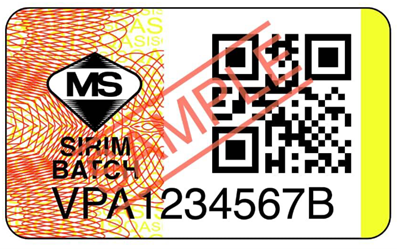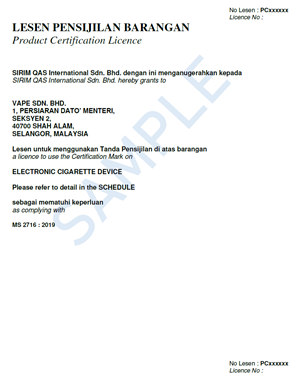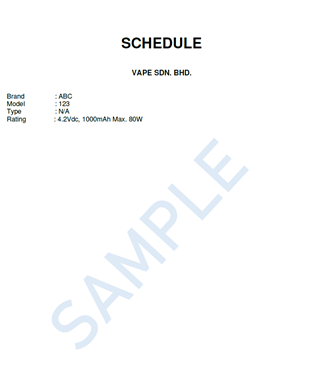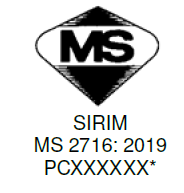
咨询热线075528506411
background:
On March 31, 2022, the Minister of Domestic Trade and Consumer Affairs of Malaysia issued an executive order Trade Descriptions (Certification and Marking of Electronic Cigarette Device) Order 2022, which will be effective in August 2022. Effective on March 3.
Glossary:
The definition of "electronic cigarette device" refers to the Malaysian Standard MS 2716 – Electronic cigarette device – Safety requirements and test methods.
Competent authority:
SIRIM QAS International Sdn. Bhd. (hereinafter referred to as SIRIM QAS) shall issue product certification certificates and product labels for electronic cigarette devices and components that comply with the MS 2716 standard.
Implementation requirements:
Anyone who provides electronic cigarette equipment and components to the Malaysian market must first apply for a certificate and label from SIRIM QAS, and post the designated label in a prominent position on the product or package.
Violation penalty:
Any failure to comply with this order is a crime and, if convicted, carries the following penalties:
If the person is a body corporate, a fine of not more than RM200,000 will be imposed; for a second or subsequent offence, a fine of not more than RM500,000 will be imposed;
If the person is not a body corporate, a fine not exceeding RM100,000 or imprisonment not exceeding 3 years or both; for a second or subsequent offence, a fine not exceeding RM250,000 or not exceeding 5 years in prison or both.
Full project test (MS 2716):
Electrical Test Electrical Test:
Risk associated with structural integrity:
Drop Test: Recharge after drop test, External short circuit test
Risk of burns
Malfunction of ECU
Incompatibility of accessories
Mechanical Test:
Risk associated with filling
Risk of injury
Risk associated with sealing
Vibration test
Shock test
Chemical Test:
The mouthpiece should be food grade compliance
EMC Test:
Radiation Emission
Electrostatic Discharge test
RF Field Strength Susceptibility
Magnetic Field Immunity
Wireless Connectivity Test:
Applicable for devices that have Bluetooth, WIFI or any communication module
Functional Test:
All function stated on the brochure should be working as declared
besides,
The battery needs to meetMS IEC 62133:2017;
The USB charger should comply with the requirements of MS IEC 60950-1.
The authentication procedure has 2 modes Type 1b and Type 5.
Type 1b is a single certification mode, the applicant is a trader, each batch of goods needs to be inspected, no factory audit is required, only the label is approved, and no certificate is issued;
Type 5 is a complete product certification model. The applicant is a manufacturer, and a factory audit needs to be arranged every year to maintain the validity of the product certificate. The label is approved and the certificate is issued at the same time.
Type 1b Certification procedure:
Importer submits application: application form + full project test report + bill of lading + invoice and packing list
Document Evaluation: Evaluate the test report and all submissions
Product Arrival: Product arrives in Malaysia
Sampling/Inspection: SIRIM QAS conducts consignment sampling and inspection
Verification test/assessment: partial project test, confirmatory test/part of key test, to ensure that the imported product is the same as the product declared in the complete type test report
Recommended/Approved
SIRIM QASLabels will be issued according to the quantity of imported products, and the applicants will purchase labels. The labels need to be posted on the smallest package of the product or on the product, as shown in the figure below.

Type 5 Certification procedure:
Submit application: application form + full project test report + bill of lading + invoice and packing list
Document Evaluation: Evaluate the test report and all submissions
Factory Audit: Factory audit of the production site, including QC program adequacy, test equipment calibration, record keeping systems and safety routine testing
Certification and Approval Process
Accreditation Panel Assessment: Preparation of Accreditation Report and Referral to Accreditation Panel
Issue a certificate
SIRIM QASLabels are issued according to the number of applications, with a maximum of 3-month production labels issued each time, the applicant purchases SIRIM Label, and the label needs to be posted on the smallest package of the product or on the product, as shown in the figure below

Annual surveillance audit/market supervision
certificate template:

Cycles and Fees:
| serial number | project | cost(RM) | cost(USD) | cycle |
| 1 | Application fee | 500 | 160 | |
| 2 | assessment fee | 3000 | 640 | |
| 3 | Certificate annual fee | 600 | 200 | |
| 4 | Factory Audit | 1200* | 300* | |
| 5 | Factory Audit Additional | Accommodation/transportation/living allowance etc. | ||
| 6 | Test fee (per model) | 16100** | 4500** | |
| A | Electrical Test | 3450 | 985 | |
| B | Mechanical Test | 4950 | 1415 | |
| C | Chemical Test | 1700 | 485 | |
| D | EMC Test | 5500 | 1570 | |
| E | Wireless Connectivity Test | 2000/mode (if applicable) | 570/mode (if applicable) | |
| F | Functional Test | 500 | 150 | |
| Total per Model | 16100 | 4500 | 48-60day | |
| 7 | Verification Test (for batch Certification, Type 1b) | 1700 | 485 | |
Note: The following 2 test fees are not included Batteries need to comply with MS IEC 62133:2017 USB charging port shall comply with MS IEC 60950-1
*Minimum factory audit fee, based on location **Minimum test fee | ||||
The serial numbers 6-7 are suitable for Type 1b mode; the serial numbers 1-6 are suitable for Type 5 mode.
other::
Factory audit content:
Component and incoming quality control: All major raw materials that have a direct impact on product performance should be subject to incoming inspection prior to acceptance and/or production. Manufacturers shall identify, perform and document testing for each raw material and compare the results to material specifications for acceptance. Incoming raw materials are subject to verification of the Certificate of Analysis (CoA)/batch/batch inspection report received by the supplier and manufacturer.
(i) Atomizer (includes – Atomizer base (includes heating coil), Atomizer and mouthpiece)
(ii) Batteries should be MS IEC 62133:2017 certified
(iii) Charging port, e.g. USB, Type C shall comply with MS IEC 60950-1
(iv) The charger/adapter shall comply with MS IEC 60950-1 / IEC 62381
Process/Line Quality Control: Applicants should ensure that adequate process controls are implemented at the facility. The manufacturer shall determine the controls of the intermediate process to ensure that the expected product quality is achieved. Main production process (depending on design):
(i) Product assembly process: visual inspection, display function
(ii) Atomizer assembly process: visual inspection, heating coil resistance
(iii) Battery circuit assembly process: visual inspection, routine testing
Below are the minimum routine tests that need to be performed 100% on the production line to cover the safety aspects of the product. Tested on the production line and witnessed during the audit.
Functional testing should cover but not be limited to:
(i) On and Off System
(ii) automatic cut-off system
(iii) Automatic shut-down
(iv) Anti-overcharge
routine test
Handling of non-conforming products
Final Inspection Before Shipment: Applicants should ensure that a final inspection is carried out. Minimum final inspection testing shall include functional testing but not limited to the same as regular testing:
(i) Visual inspection
(ii) Functional test (switching system, automatic shutdown system, automatic shutdown, anti-overcharge)
The minimum frequency of testing depends on the manufacturer's quality management system.
Equipment Calibration: At a minimum, calipers and multimeters are required, and make sure they are calibrated
maintenance of records
Identification, Packaging and Labeling
The product needs to be marked with:
Names, trademarks or other information identifying the manufacturer or supplier
Voltage (V), Capacity (mAh), Power (W)
Standard number and year
The SIRIM label is attached to the product or the smallest package
Packaging needs to identify the content:
Names, trademarks or other information identifying the manufacturer or supplier
Standard number and year
SIRIM certification mark, as shown in the figure below, the certificate number must be consistent with the product certificate (only type 5 mode is supported)


Certification Marking Method
Laser printed or embossed on the product
printed on each box
For more details, please pay attention to the element detection WeChat public account to keep abreast of the latest solutions.
联系电话
微信扫一扫
